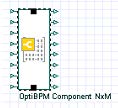We are now ready to embark into the main part of the paper. Namely, we have already shown we could divide an advanced circuit into smaller parts that are suitable for the BPM analysis. We have also the S-data tool to provide the effective mathematical description of all those particular sub-elements. The last part missing in our account is to find an environment connecting the sub-elements into the entire circuit. To reach our goal, we used OptiSystem, which provides a very flexible environment for schematic designing and simulation of advanced optical communication systems. Any complex circuit can be assumed to be an optical system, and OptiSystem can be very effectively used as the “motherboard” in the presented study.
The practical implementation is trivial from a customer point of view. At this point, keep in mind that we have the sub-elements characterized in the form of small files. OptiSystem introduces a general component OptiBPM Component NxM that can load these small files easily.
 The component on the left is shown with its default value of 8×8 input/output ports. Apparently, we do not need much additional description saying that the loaded component by the *.s file reads firstly the headings, i.e. the number of both ports and automatically adapts the icon to have the correct number of ports (visually can be seen in the solved examples below). The OptiSystem environment also follows the unidirectional of the BPM, this can be seen from the icon by the orientation of the port arrows (from left to right). We are now able to fully exploit a number of various OptiSystem facilities to analyze a given circuit. This brings an immense flexibility into the circuit simulations. Moreover, we can decrease the simulation time comparing the new approach with a BPM run. We will demonstrate these improvements by solving the four examples previously mentioned.
The component on the left is shown with its default value of 8×8 input/output ports. Apparently, we do not need much additional description saying that the loaded component by the *.s file reads firstly the headings, i.e. the number of both ports and automatically adapts the icon to have the correct number of ports (visually can be seen in the solved examples below). The OptiSystem environment also follows the unidirectional of the BPM, this can be seen from the icon by the orientation of the port arrows (from left to right). We are now able to fully exploit a number of various OptiSystem facilities to analyze a given circuit. This brings an immense flexibility into the circuit simulations. Moreover, we can decrease the simulation time comparing the new approach with a BPM run. We will demonstrate these improvements by solving the four examples previously mentioned.

